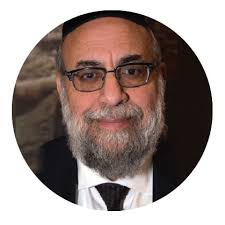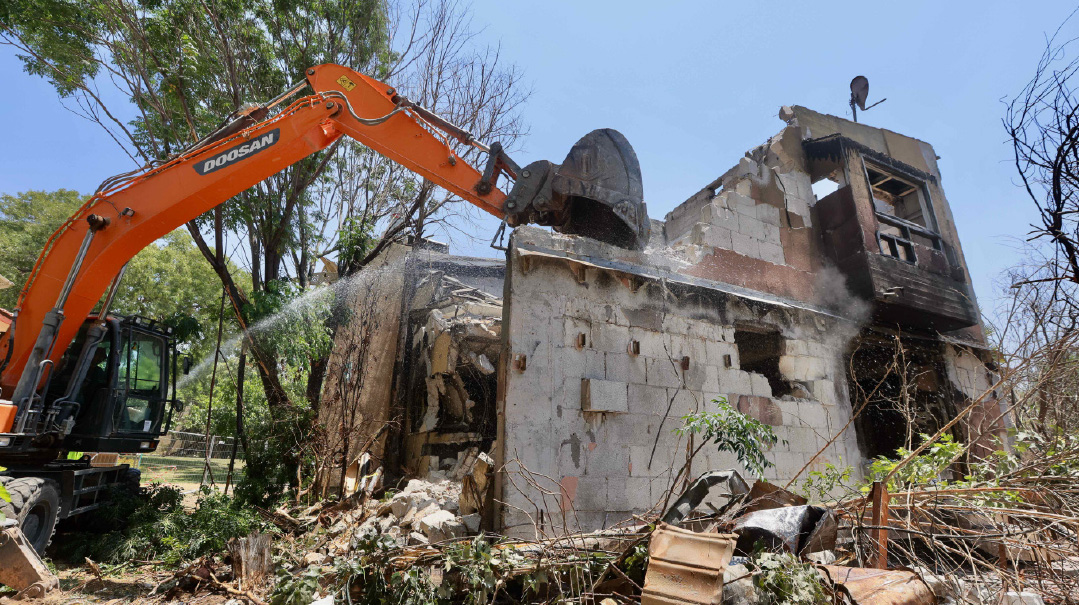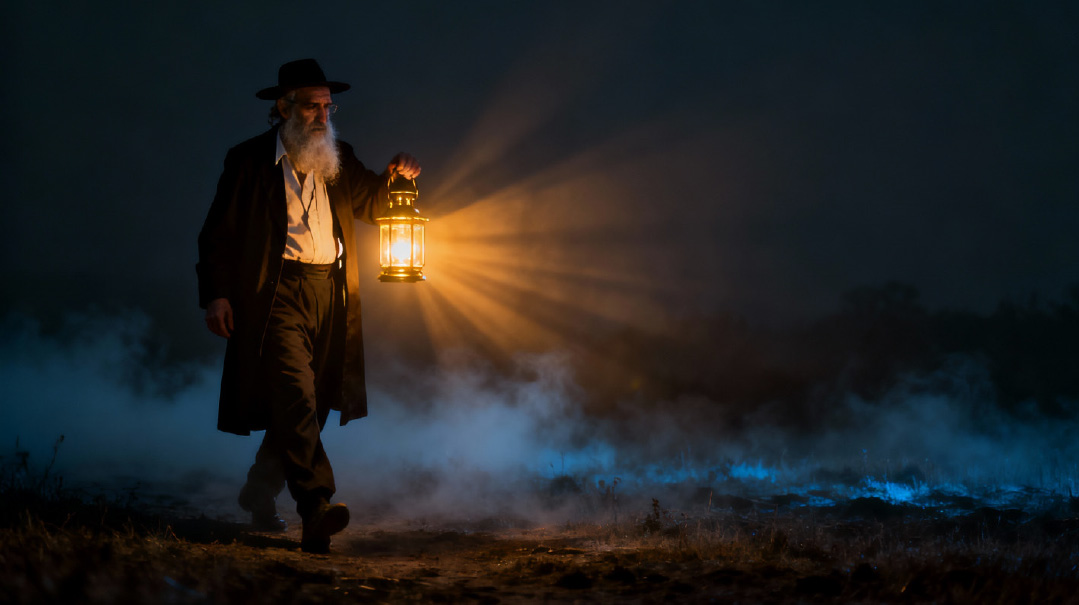A Year of Tishah B’Avs

Commentators have almost universally characterized this year as the worst for Jews since the end of the Shoah

P
rior to this year’s Yamim Noraim, many writers (including this one) were focusing on Chazal’s comment, “Kol shanah she’ein tokin lah bitechilasah meri’in lah b’sofah — Any year when the shofar is not blown on Rosh Hashanah will have bad tidings at the end.” Everyone wondered what kind of year could be anticipated for Tash”pad (5784). Historians cited research on what actually followed a Rosh Hashanah that fell out on Shabbos: how many difficult years, how many years of plenty. The next time the calendar offers such a scenario, this year will doubtless be featured atop the list of difficult years.
Indeed, commentators have almost universally characterized this year as the worst for Jews since the end of the Shoah. The suffering and loss of life on such a large scale is clearly unparalleled in modern times. Over the last few months, I have begun referring to Tash”pad as “a year of Tishah B’Avs.”
While this year has all been about Tishah B’Av, in actuality, every tragedy and pain inflicted upon Klal Yisrael, whether this year or in any past year, whether individual or collective, has its ultimate source in Tishah B’Av.
In sefer Kolmus Halev (pg. 201), a story is told of a meeting that took place at the home of Rav Chaim Ozer Grodzenski and a group of rabbanim in Vilna at the beginning of World War II. An attendee commented that the difficulty and tzaros that the Jewish People were going through then were more difficult than the years leading up to the Churban Bayis. While at first Rav Chaim Ozer did not respond to that comment, he later turned toward Rav Avrohom Kalmanovich (the founder of Mir Yeshivah in Brooklyn), and said that this statement was incorrect. For every tzarah that befalls Klal Yisrael, in every age, stems from the Churban Bayis.
Chazal tell us of an Amora who observed two days of Tishah B’Av, the 9th and the 10th. The Gemara questions how he could be allowed to do that; was he not in violation of the issur of bal tosif, as one would be for adding on to any Yom Tov? The answer is that adding an extra day to a Yom Tov does not make it a Yom Tov, whereas adding a day of mourning for the Churban Bayis and for the realization that we are still in galus is not inappropriate, as it is something that we should be feeling every day of the year.
A prominent secular Jewish commentator for years has tried to explain away hateful acts or words directed at Jews as not really being anti-Semitism per se but rather just an extension of world conflicts. The Navi Yeshayahu disagrees with his self-taught analysis: It is all about Klal Yisrael. The pasuk in Yeshayahu says that Hashem promised Klal Yisrael that in honor of Tzion, He would not hold his peace, and for the sake of Yerushalayim, He would not be still. The Targum explains this pasuk to mean that Hashem is promising that until Tzion and Yerushalayim are peaceful and secure, He will allow no rest to come to the earth. In essence, the Navi is telling us that due to the situation in Eretz Yisrael, the world as we know it will never be at peace.
Over the ten months since October 7, this writer has commented often (in this very publication) on the many scenes of devastation I have witnessed during trips to the ravaged towns of the south and the deserted communities of the north. I have described painful encounters with individuals and communities who have suffered so terribly, and who continue to suffer as these words are being written.
We spoke about the need for continued tefillos for our soldiers and their families, for the hostages and their families and for Eretz Yisrael in general. We spoke about the need to fight our feelings of indifference, of burnout, and of being “tefillah’ed out.” And most importantly, the need to feel the pain of Acheinu Beis Yisrael.
What I find personally troubling is that many of us are spending these weeks of the summer in the Catskills, enjoying the slower pace and the cooler air, yet we somehow left our thoughts and concerns for Eretz Yisrael behind on the other side of the George Washington Bridge. I have heard from many people, wherever I go (obviously in response to an article I wrote a few months back about being “tefillah’ed out”), that although their shul back home would never conclude the davening without a kapitel Tehillim, morning or evening, for some reason many of the shuls upstate do not.
There are many people who have made a concerted effort to travel to Eretz Yisrael just to show support and to provide financial support to the cab drivers, restaurants, and local vendors. One member of our shul, who just returned from a weeklong visit, told me that during his trip he was stopped by complete strangers who thanked him for coming to Eretz Yisrael.
The many Yidden who are using this time to travel to exotic destinations around the world should take note of the important lesson that the Belzer Rebbe taught all of us, when he refused to go to his vacation home in Telz Stone to show he identified with Acheinu Beis Yisrael who are in the alleyways of Rafah, in Jenin, or in the underground prison cells of Gaza. While most of us are not on the level of the Belzer Rebbe, by any stretch, this should at least provide us with some food for thought.
I would like to share with you a project that began to percolate in my mind the week after Shavuos, when I had the opportunity to go to Tel Hashomer Hospital with a dear friend to offer some chizuk to wounded soldiers who had already spent months recuperating. Some were missing limbs, some had lost their sight, others had endured many surgeries, with more to follow. We went to give chizuk, and in retrospect, we clearly received it.
I asked them to share their personal stories — where they came from, what their experiences were in the Gehinnom of the Gaza battlefields — and then to share their hopes and dreams for the future. At that moment, I realized that I just did not get it. I do now.
Before, it was all about a “war,” and the numbers. How many dead, how many wounded, how many hostages, how many people displaced from their homes (many permanently). Now I realized that I had been going about it all wrong. It is not about numbers; it is about individuals. Someone’s son, husband, brother, father, daughter, wife, sister, mother. There are whole families in utter turmoil and confusion and full of pain.
I realized then, as I wrote in an earlier article, titled “From Kfar Azah to Bnei Brak,” that after spending considerable time visiting the ravaged communities down south, I was unsure as to what was my responsibility was now. And so, the next day, I went to Bnei Brak to ask several of the gedolei hador that very question.
One of the gedolim I spoke to, Rav Moshe Hillel Hirsch, rosh yeshivah of Slabodka, told us to go back to the States and share what we had seen with Klal Yisrael so they could understand what had happened over there. I took the gadol’s direction very much to heart, and my wife and I traveled to many cities and towns, sharing the horrific events that occurred in Eretz Yisrael from a personal perspective of boots on the ground. Baruch Hashem, the Rosh Yeshivah was correct: Our talks led to so many new chesed and tefillah initiatives on behalf of Klal Yisrael.
Now, months later, I realized that it was just not enough. Our focus was on the general colossal tragedy, but not enough on the individual. We need to focus on the people themselves. We need to learn their names, recognize their faces, hear their stories, and then and only then can we truly feel for their plights.
And so we went back to the Slabodka Rosh Yeshivah and shared with him my new goal, to share some of their personal stories with the general community. The Rosh Yeshivah responded that it might just be too difficult for people in chutz l’Aretz to listen to these stories and then go back to their regular day-to-day obligations. I countered to the Rosh Yeshivah that I fully agreed that for 364 days of the year, it would indeed be too difficult to absorb. However, on one day — the day of Tishah B’Av — it is exactly what Klal Yisrael should be able to do. Indeed, what it must do.
After a few weeks in Eretz Yisrael, I returned home and reached out to a friend, a talented young man named Yaakov Langer of Living L’chaim, and shared my idea of creating a Tishah B’Av video to show to Klal Yisrael, to be titled “A Year Of Tishah B’Av.” It would feature a few brief personal stories of Yidden who have suffered so much, lost so much, and yet, with herculean strength and seemingly unlimited emunah, have been able to move ahead and rebuild their lives and the lives of their families in the best way possible.
I wanted to focus on the very different painful experiences that people are going through, so I made several different categories of interviewees, to ensure we were getting a broad picture. I started with a list of 25 possibilities, and then, due to logistics concerns and time constraints, I narrowed it down to just 12 people. We then began searching for the interview candidates who could best articulate their feelings.
On our trips to Eretz Yisrael over the past months, and our travels to communities down south and up north, I met many different people who were worthy candidates. In the course of interviewing several of them, we were in turn introduced to others, and some of them became the focus of the video.
Our time at Tel Hashomer Hospital, meeting wounded soldiers, brought us into contact with the staff, who recommended that we also speak with certain other soldiers we hadn’t even met before, and their stories were invaluable.
We met several former hostages through the auspices of Rabbi Shai Shechter, who had hosted them in his home; Josh Wander from Maaleh Zeisim, who is a leading member of Zaka; and United Hatzalah, who helped us with some of the interviews as well.
When we invited people in to sit for interviews, I told them that my whole purpose in doing this video is to give Jews in America a proper perspective on the situation in Eretz Yisrael. Yidden in the States are very concerned, but unfortunately, they just do not get it. The focus is on numbers — of victims, of hostages, of days in the war — and not enough on the real people who have suffered (and continue to suffer) so much. By telling their stories, these people would be able to give the real picture of just how horrific this war has been for Klal Yisrael. I guess this resonated with them, as they agreed to do the interviews.
The viewers will have the opportunity to meet a released hostage, a family member of a current hostage, two survivors of the Nova music festival, the sole remaining member of a family torn apart by a terrorist attack, soldiers recuperating from severe wounds, and one of the heads of Zaka who was among the first to enter the destroyed communities the day after October 7. Along with these, there will be a visual presentation of the horrific aftermath (nothing gory will be shown) in the ravaged communities.
One of the most difficult interviews we conducted was with a person from Kibbutz Be’eri named Avida Bachar, who hid with his family in a bunker on October 7. On that day, he lost his wife, a son, and a leg. He is still in rehab trying to learn how to navigate with only one leg. We were advised by the head doctor at the rehab that we had to speak to him first — we wouldn’t be disappointed.
He is not frum (yet), but words of emunah just flowed from this incredible Yiddishe neshamah. During the interview, the videographer could not stop crying. The editor reviewing the video could not stop crying either. And though the editing team and the producer were warned about how the interview had affected others, when they saw it, they could not stop crying either.
Some interviewees, when they were asked to describe their experiences in their own words, were able to start out strong, but broke down when they tried to share their stories.
We set up an interview with a former hostage who had been released after 55 days of captivity. We were told not to ask any detailed questions, as she was still suffering (understandably), and to just let her talk. We had planned on videotaping the interview on a Wednesday evening, but that afternoon, we were notified that she was in no shape to talk to us.
That morning, the news had broken that soldiers had found five bodies of hostages buried deep in a tunnel and brought them back for burial. Well, one of the bodies that was found had been a young man who was held together with this young woman.
While in captivity, she was unable to cope, but he talked to her and gave her the strength to persevere and hold on. After 35 days, she was separated from him, and 20 days later, she was freed along with other women. She credited him with keeping her alive and davened every day for him to return safely. When she heard that his body had been found, she just fell apart and was no longer able to speak with us.
Through our contact, I relayed to her that her non-interview was more painful to me than the interviews we were able to do.
Another very emotional interview was with Donna Cohen. While her town was not attacked that day, her husband heard what was taking place, and he grabbed his gun and ran out the door to help the people in need, telling his wife he would be back soon. He was killed in a gun battle later that day. She is now alone and raising her children by herself. She lives in indescribable pain, but she shows her strength in continuing with her new life as a widow .
We interviewed Rabbi Doron Perez, the head of world Mizrachi, who lost a son in the war. The interview was powerful, but the footage of him visiting his son’s grave was utterly heartbreaking.
For me personally, the image of so many fresh new graves spread out on Har Hertzl, each containing the remains of a young soldier killed in Gaza since October 7, was extraordinary painful to observe.
As I explained to Rav Moshe Hillel Hirsch, the Slabodka Rosh Yeshivah, all of our efforts and our great expense were for only one purpose. To reframe the perception of this tragic and horrific war from a focus on numbers to a focus on real people. Every one of them is a real person, with a name and a face and loved ones whose lives have been turned upside down as a result. Every individual is a universe unto itself.
Several of the great baalei mussar have commented on the juxtaposition of the parshah of eglah arufah with the details of the wars Klal Yisrael faced in the desert prior to entering Eretz Yisrael. They explained that the Torah’s message is that despite the great loss of life that results from waging wars, one should lose neither the focus on nor the appreciation for every individual life in Klal Yisrael. Even a totally nameless stranger found by the road on the outskirts of town is significant, and we should never lose sight of that.
There are two themes that infuse Tishah B’Av: Churban, and ahavas Yisrael. Rav Aaron Lopiansky, the Rosh Yeshivah of the Yeshivah of Greater Washington, who so values the importance of bringing this message into every Yiddishe home on the very day of Tishah B’Av, will share some heartfelt thoughts on this video as well.
Our vision and hope are that as this video on a “year of Tishah B’Avs” will be watched in every home (regardless of community affiliation) and followed by some serious soul-searching, as is generally done by Yidden on this day all over the world. Without a doubt, it will bring a greater and deeper appreciation of the often-repeated words of “Acheinu kol beis Yisrael hanesunim batzarah u’vashivyah.”
The video can be viewed via LivingLchaim.com (or via YouTube.com/Living Lchaim) and will be free of charge and available throughout Tishah B’Av. May this greater awareness bring with it a greater urgency of tefillah for Eretz Yisrael and Klal Yisrael.
The Navi Yeshayahu tells us that HaKadosh Baruch Hu set up shomrim (guards) to guard the walls of Yerushalayim day and night. Who are these shomrim? Where are they? The Radak on the pasuk explains that the shomrim are those among us who daven each and every day for the rebuilding of Yerushalayim and the Beis Hamikdash. In our tefillos in the morning and in the evening, we daven for “boneh Yerushalayim” and for “Es tzemach Dovid.” We are the true shomrim and protectors of the walls of Yerushalayim. We are now, and we always have been.
Let’s redouble our efforts and our tefillos, to continue to be the shomrim and the protecters of the ancient walls of Yerushalayim. And in that zechus, may we merit to see the rebuilding of those walls with the coming of Mashiach and the final end to all Klal Yisrael’s suffering, once and for all. May it happen speedily in our day.
Rabbi Chaim Aryeh Z. Ginzberg is the rav of the Chofetz Chaim Torah Center of Cedarhurst and the founding rav of Ohr Moshe Institute in Hillcrest, Queens. He is a published author of several sifrei halachah, and a frequent contributor to many magazines and newspapers, where he writes the Torah hashkafah on timely issues of the day. He is also a sought-after lecturer on Torah hashkafah at a variety of venues around the country.
(Originally featured in Mishpacha, Issue 1023)
Oops! We could not locate your form.






